Working from home is more common these days, but honestly, creating a space that feels both professional and personal can be a real challenge. A well-designed home office isn’t just about appearances—it genuinely helps you get more done.
Remember to repin your favorite images!
The right mix of furniture, lighting, and organization can turn even the tiniest corner into a productive workspace that feels like yours.
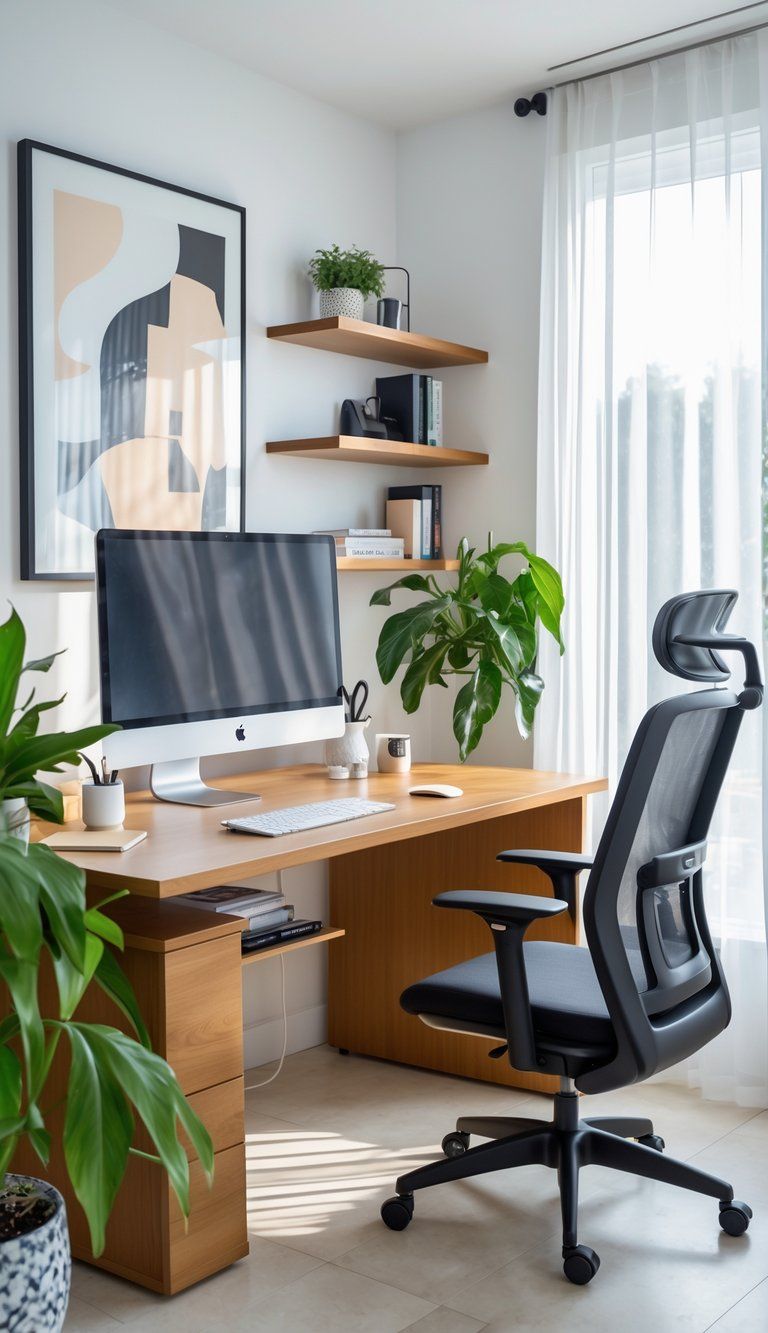
Your home office should be more than a desk and chair. You need a spot where you actually want to spend hours working, but also somewhere that keeps you focused and motivated.
Pick a location with good natural light. Invest in a comfortable chair. Add personal touches so the space feels like it belongs to you.
Even if space is tight, you can still make a home office work. Use smart storage to keep clutter away. Thoughtful design choices can make a small area feel bigger and more usable.
The goal? Create a workspace that supports how you work and actually feels inviting.
Designing a Dedicated Workspace

A dedicated workspace matters so much for productivity at home. When you set things up right, you cut down on distractions and really get things done.
Choosing the Ideal Location
Location can make or break your home office setup. Try to find a quiet spot away from the busiest areas of your home.
Natural light boosts your energy and mood. If you can, grab a spot near a window.
Corners often work well, giving you two walls for furniture. If you can close a door, even better—having a physical boundary helps you separate work and home.
Check for nearby outlets and a strong internet signal. There’s nothing worse than setting up your whole office only to realize WiFi barely reaches.
And don’t forget the view. Looking out at some greenery or the sky can give your eyes a break.
Space Constraints and Creative Solutions
Small spaces don’t have to limit your productivity. Wall-mounted desks fold up when you’re done, so you get your floor back.
Floating shelves above the desk give you vertical storage without eating up space. Multi-purpose furniture—like an ottoman with storage or a dining table that doubles as a desk—can be a lifesaver.
Room dividers or tall bookcases can carve out an “office” in open layouts. Get creative with underused spots: closets, stair landings, even a nook in the hallway can work with a bit of imagination.
Space-saving desk options:
- Corner desks
- Wall-mounted folding desks
- Secretary desks that close up
- Rolling carts you can stash away
Small Home Office Design Tips
Keep clutter out of sight with smart storage. Use desk organizers, wall pockets, and cable management to keep things tidy.
Light colors on walls and furniture make the room feel bigger. Mirrors bounce light around and add the illusion of space.
Pick furniture that fits—giant desks just crowd a small room. Compact ergonomic chairs that tuck under the desk are a smart choice.
Look for dual-purpose items, like a filing cabinet that holds your printer. Magnetic boards or pegboards use wall space for storage.
Lighting matters, especially in small rooms. Mix task lighting and ambient lighting to keep your eyes happy and your space inviting.
Optimizing Home Office Productivity
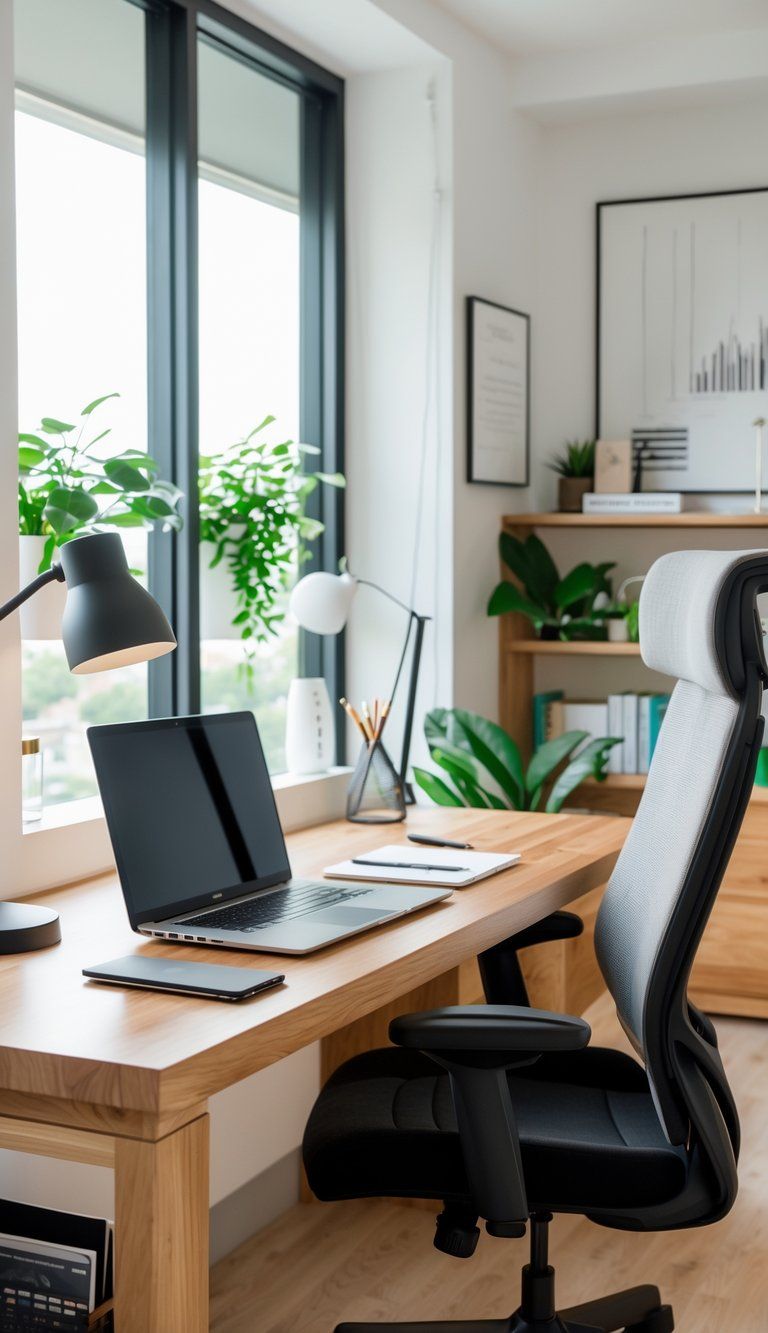
Planning and organizing your home office can seriously boost your focus and efficiency. A good setup makes a huge difference in how you feel about working from home.
Minimizing Distractions
A distraction-free zone is key for remote work. Choose a quiet spot away from busy areas.
If you share your space, try noise-canceling headphones or a white noise machine. Visual distractions can be just as bad as noise—keep your desk clear of non-work stuff and face away from high-traffic spots or distracting windows.
A simple bookshelf or room divider can help carve out your workspace. Digital distractions are sneaky. Try these:
- Use website blockers during focused work time
- Turn off unnecessary notifications
- Put your phone on Do Not Disturb
- Set specific times to check emails and messages
Maximizing Work Efficiency
How you set up your space directly affects your productivity. Get an ergonomic chair and make sure your monitor sits at eye level.
Good lighting cuts down on eye fatigue. Put your desk near natural light but avoid screen glare.
Keep your most-used items within reach. Organize everything else so it’s easy to find. Digital organization matters too—set up logical folders and use apps to track tasks.
Try a few time management tricks:
- Time blocking: Tackle specific tasks during your best hours
- Pomodoro technique: Work for 25 minutes, then take a short break
- 2-minute rule: If something takes less than 2 minutes, do it right away
Creating Zones for Focus and Breaks
Different tasks need different setups. If you can, create separate zones in your home office.
Focus zone: Make your main workspace all about concentration. Keep it tidy and stocked with what you need.
Collaboration zone: For video calls or teamwork, set up a spot with good lighting and a neutral background.
Break zone: Even a small armchair or window seat gives you a place to step away. Short breaks keep burnout at bay and actually help you get more done.
Move around a bit. Stand up every hour, stretch, or take a quick walk. These tiny breaks really add up for your energy.
Selecting Ergonomic Furniture
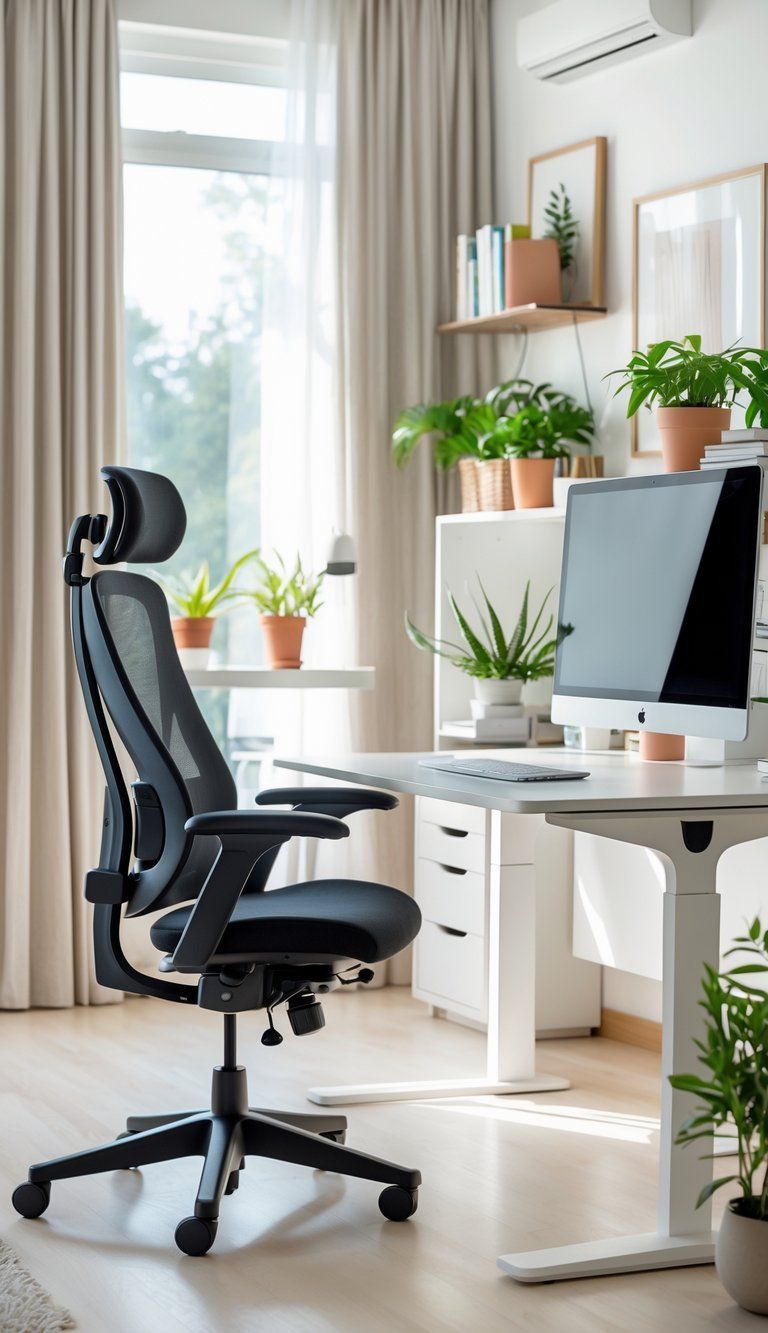
The furniture you pick for your home office really impacts your comfort, health, and how much you get done. Ergonomic pieces support your body and help you avoid long-term aches and pains.
Ergonomic Chairs and Comfortable Seating
A quality ergonomic chair is the base of a productive workspace. Look for adjustable height, seat depth, and armrests so you can tweak it to fit you.
Lumbar support matters a lot to keep your spine happy during long hours. The best chairs let you adjust several things. Your feet should rest flat, knees at 90 degrees, and elbows supported while typing.
Materials count too. Breathable mesh backs keep you from overheating, and cushioned seats spread your weight evenly.
Key features:
- Adjustable height, tilt, and armrests
- Good lumbar support
- Breathable materials
- 5-point base for stability
- Weight capacity that matches your needs
Choosing a Suitable Desk
Your desk is the heart of your office. Standard height is about 29-30 inches, but really, you want your arms at 90 degrees when typing.
Think about how you work—L-shaped desks are great for spreading out or using multiple monitors. Straight desks fit better in small rooms.
Materials affect both look and function. Solid wood is sturdy but pricier, while laminate is budget-friendly and easy to clean.
Desk features to consider:
- Height that works for you
- Enough surface space for your gear
- Cable management options
- Storage (drawers or shelves)
- Materials that fit your style
Sit-Stand and Standing Desks
Sit-stand desks are a game-changer, letting you switch between sitting and standing. This movement helps you avoid the health pitfalls of sitting all day.
Manual models use cranks or levers and cost less. Electric ones are easier but more expensive. Some even remember your favorite heights.
When standing, keep your monitor at eye level and elbows at 90 degrees. Anti-fatigue mats make standing more comfortable.
Benefits:
- Less time sitting
- Better energy and focus
- Can help with back pain
- Encourages movement
- Lots of sizes for different spaces
Multifunctional and Space-Saving Furniture
In small home offices, multifunctional furniture is a lifesaver. Floating desks mount to the wall and free up the floor.
Desks with built-in shelves give you storage without taking up extra space. Fold-down desks hide away when you’re done, turning your office back into living space.
Look for hidden storage to keep supplies out of sight. Modular pieces let you rearrange things as your needs change.
Space-saving ideas:
- Wall-mounted desks
- Nesting tables
- Corner desks for awkward spots
- Furniture with built-in cable management
- Adjustable monitor arms to clear desk space
Enhancing Lighting for a Productive Workspace
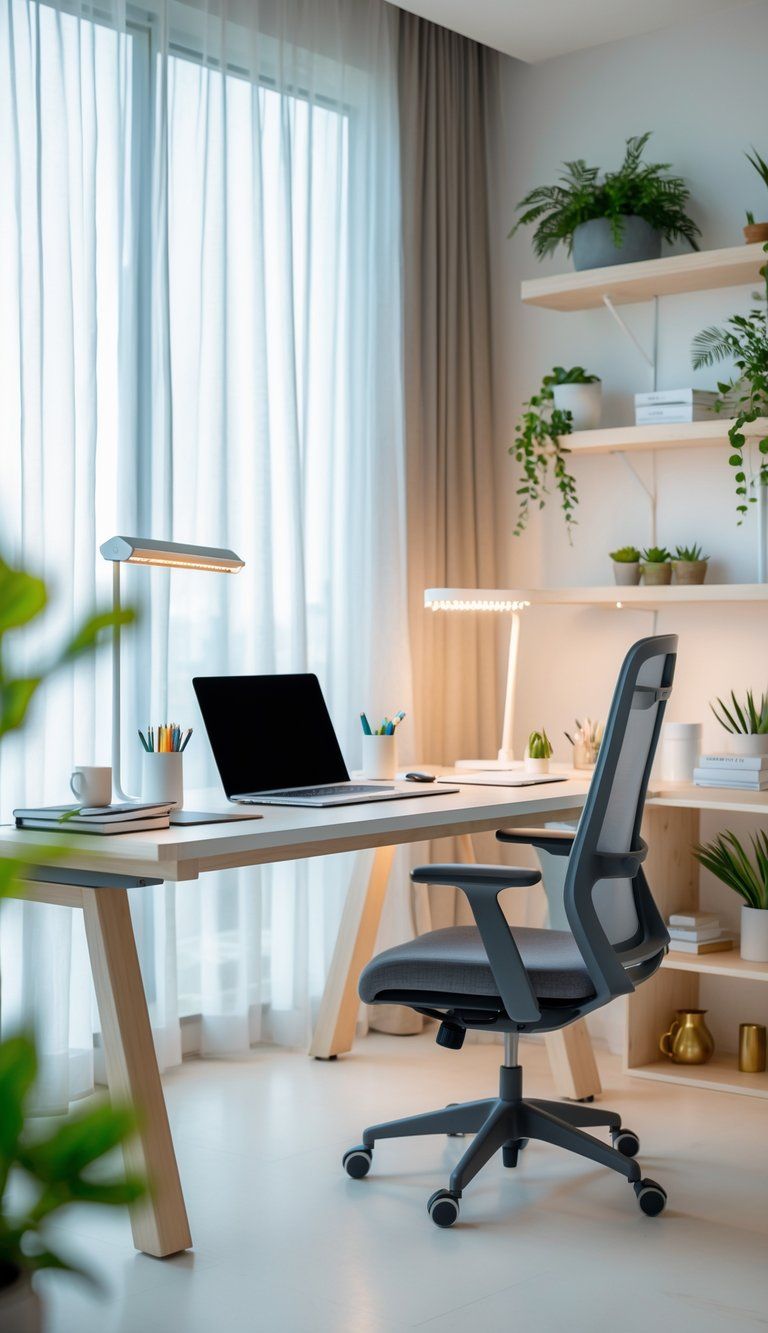
Lighting can totally change your home office vibe. The right setup keeps your eyes comfortable, lifts your mood, and helps you focus.
Maximizing Natural Light
Start with natural light when setting up your office. Put your desk near a window—daylight really does make you feel better and work better.
If you can, pick a room with windows facing east or north. This helps you avoid harsh sun glare. Sheer curtains or adjustable blinds let you control brightness as the day goes on.
If you don’t have many windows, try bouncing light around. Mirrors opposite windows help, and light-colored walls and glossy surfaces reflect light deeper into the room.
Don’t block windows with big furniture or heavy drapes. Keep the space open so sunlight can reach every corner.
Ambient Lighting Considerations
Ambient lighting sets the scene for your whole office. You want it bright enough to see but not so harsh that it feels like a hospital.
Ceiling fixtures with dimmable options let you adjust the light level. Semi-flush mounts or recessed lights spread light evenly and keep things looking clean.
Layer your ambient lighting with a few different sources to avoid shadows. Ceiling lights plus a floor lamp or two can really help.
Color temperature matters more than people think. For daytime, go with bulbs in the 4000-5000K range—”cool white” keeps you alert and focused.
Later in the day, switch to warmer lighting (2700-3000K) to help your brain wind down and get ready for sleep.
Task Lighting Essentials
Task lighting puts bright light right where you need it for detailed work. Even in a room that’s already well-lit, a quality desk lamp really makes a difference.
Pick an adjustable lamp so you can aim the light exactly on your work area. Lamps with articulating arms and rotating heads give you lots of flexibility.
The best task lamp lights up your workspace without causing screen glare. Place it on the opposite side of your dominant hand to cut down on shadows when you write.
LED task lights bring some real perks—energy savings, less heat, and bulbs that seem to last forever. Most new models let you adjust brightness and color temperature too.
If your desk is small, try a clip-on lamp or a monitor-mounted light to save space. Some clever task lights even have USB charging ports, which is super handy.
Smart Lighting Systems
Smart lighting changes the way you control your office vibe. You can tweak brightness and color temperature all day long, and you don’t have to stop working to do it.
Set up programmable schedules so your lights shift from cool and energizing in the morning to warm and cozy in the afternoon. That keeps your body clock happy and helps your eyes feel less tired.
Voice controls let you change the lights hands-free, which is great during calls or when you’re in the zone. Most systems work with Alexa or Google Home, so there’s no learning curve.
Motion sensors take it a step further—they turn lights on when you walk in and off when you leave. Saves power and you never have to hunt for the switch.
Some smart setups even sync with your calendar, changing the lighting for video calls, reading, or computer work. It’s pretty wild how much you can automate now.
Creating a Comfort-Driven Environment
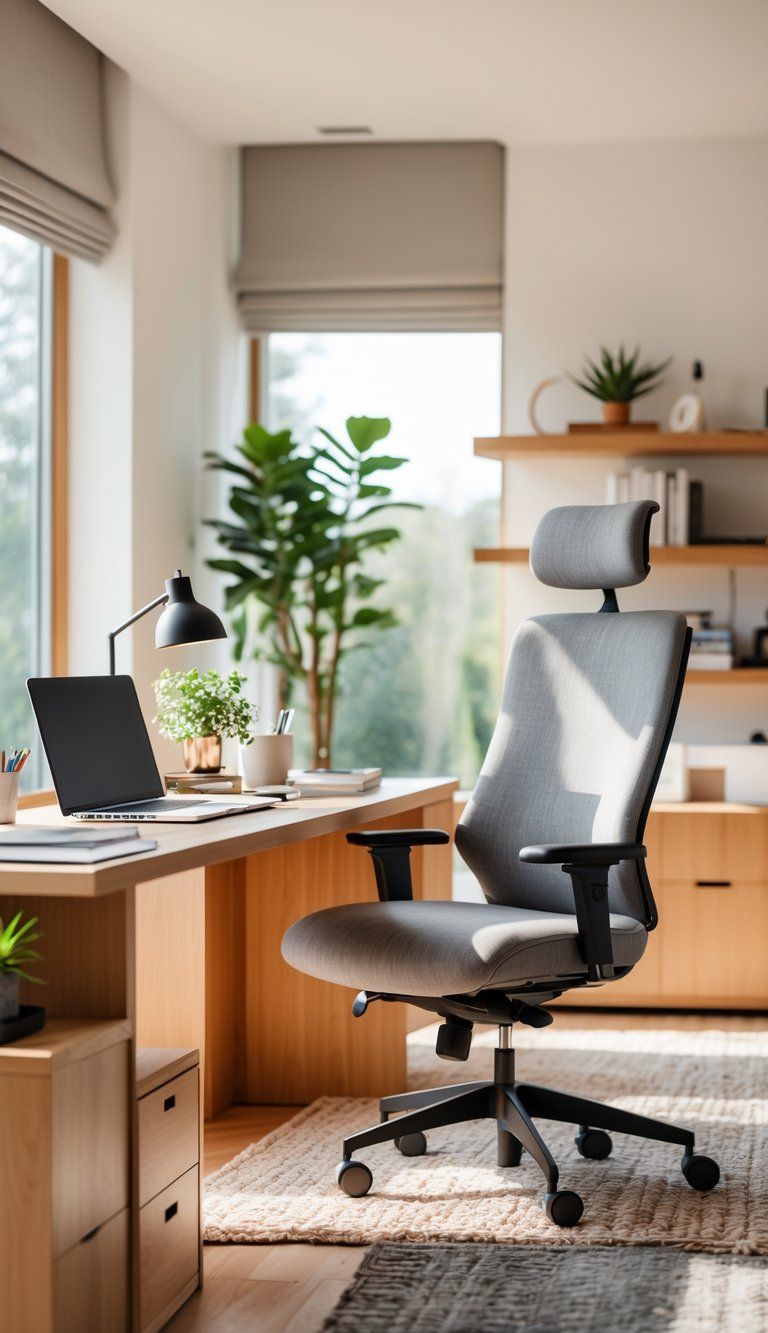
A comfortable home office just makes everything easier. When your body feels good, you can focus and actually get stuff done.
Temperature and Air Quality
Your body works best when the temperature is just right. Try to keep your office between 68-72°F (20-22°C). If it’s too cold, your fingers freeze up; too hot, and you’ll start nodding off.
Here are a few ways to stay comfortable:
- Plug in a small space heater for those chilly corners
- Use a desk fan or a portable AC when it’s hot
- Hang thermal curtains to block out heat or cold from windows
Air quality is just as important as temperature. When the air’s bad, you get headaches and feel wiped out. Here are some ideas:
- Add air-purifying plants like snake plants or peace lilies
- Use an air purifier with a HEPA filter
- Crack a window for fresh air when you can
- Dust and clean your space regularly
Noise Reduction Strategies
Noise can wreck your focus in seconds. It’s worth figuring out how to make your space quieter.
First, spot the main noise culprits. Is it traffic outside, family, or some loud appliance? Once you know, you can actually fix it.
Try these noise reduction techniques:
- Put weatherstripping around doors and windows
- Hang acoustic panels (they can look pretty cool too)
- Push a bookshelf against shared walls to soak up sound
- Throw down thick rugs to muffle footsteps and chair noise
If you can’t block all the noise, invest in noise-cancelling headphones. They’ll shut out distractions so you can work or just enjoy some music.
Set up a quiet zone in your home. Even a simple sign or a light can let others know when you need to focus.
Incorporating Organization and Storage Solutions

A tidy home office is the real secret to getting things done. Smart storage keeps everything you need close by and makes your space look good too.
Decluttering for a Clutter-Free Workspace
Start by clearing off your desk and only keeping what you use every day. The “one touch” rule actually works—deal with each paper or item once, then file or toss it.
Set up designated zones for different tasks. Maybe one spot for writing, another for your computer, and a shelf for reference stuff. This keeps your mind clear and saves time hunting for things.
Take a few minutes at the end of each day to tidy up. File papers, put away supplies, and get your desk ready for tomorrow.
A good filing system makes life easier. Color-coded folders or digital tools help you find what you need fast.
Effective Storage Solutions
Go vertical with wall-mounted shelves or bookcases. That keeps your desk clear and your essentials easy to spot. Floating shelves add style and function at the same time.
Try under-desk drawers or small cabinets for stuff you use often. If you pick cabinets with wheels, you can move them around as needed.
Look for furniture that does double duty:
- Desks with built-in drawers
- Ottomans that hide storage inside
- Decorative boxes that keep office supplies out of sight
Use the inside of cabinet doors by adding hooks or little containers for things you grab a lot. It’s a sneaky way to keep things organized.
Don’t ignore digital storage. Cloud drives and external hard drives cut down on paper piles.
Cable Management and Desk Organizers
Cables can get out of hand fast. Use cable clips, sleeves, or boxes to wrangle the mess. Label each cord so you know what it belongs to.
Put your desk near an outlet or use a surge-protected power strip. It keeps cords neat and off the floor.
Pick desktop organizers that look good and actually help:
- Pen holders for all your writing tools
- Paper trays to sort mail and documents
- Small containers for paperclips, sticky notes, and the random little things
Match organizers to your style. Wood works for a classic feel, while acrylic or metal looks sharp in modern spaces.
Drawer dividers stop small stuff from turning into a junk drawer. Change up your system as your needs shift.
Personalizing with Style and Decor

Your home office should feel like yours, not just another bland workspace. When you add personal touches, you’ll actually want to spend time there.
Color Schemes and Color Psychology
Colors really mess with your mood and focus, for better or worse. Blue helps you stay calm and sharp—great for tasks that need concentration. Green is easy on the eyes and brings a sense of balance, while yellow can spark creativity and optimism.
Try painting an accent wall in a color that suits your work style. If painting isn’t an option, go for colorful accessories, cushions, or storage bins.
Stick to two or three main colors for a professional look. This visual harmony keeps things interesting but not overwhelming. Neutral walls with pops of color let you change things up easily.
Think about your work—cooler colors for analytical jobs, warmer ones for creative work.
Gallery Wall and Art Displays
Art makes your workspace more interesting and gives your eyes a break. Create a gallery wall with pieces that matter to you—family photos, quotes, or art you actually like.
Some quick tips for arranging your gallery wall:
- Lay out your frames on the floor first to test the look
- Leave 1-2 inches between frames for breathing room
- Mix up frame sizes and directions for variety
- Show off achievements like diplomas or awards
Don’t crowd every inch of wall space. A few good pieces have more punch than a cluttered mess. Hang art at eye level so you see it while you work.
Nature scenes in art can lower stress and help you focus. Swap out pieces now and then to keep things feeling new.
Seasonal Decor and Accents
Changing up your decor with the seasons keeps your office from getting stale. Even small touches can make a big difference.
Try these ideas:
- Spring: Fresh flowers, lighter curtains, pastel colors
- Summer: Add tropical plants, bold colors, or natural textures
- Fall: Go for warm lights, cozy fabrics, and earthy tones
- Winter: String lights, evergreens, or metallic accents
Swap out desktop accessories like pencil cups or mouse pads for a quick seasonal refresh. Plants work year-round and make the air better too.
Show off souvenirs or mementos from trips. Items that remind you of goals or good memories can give you a boost on tough days.
Boosting Creativity in the Home Office
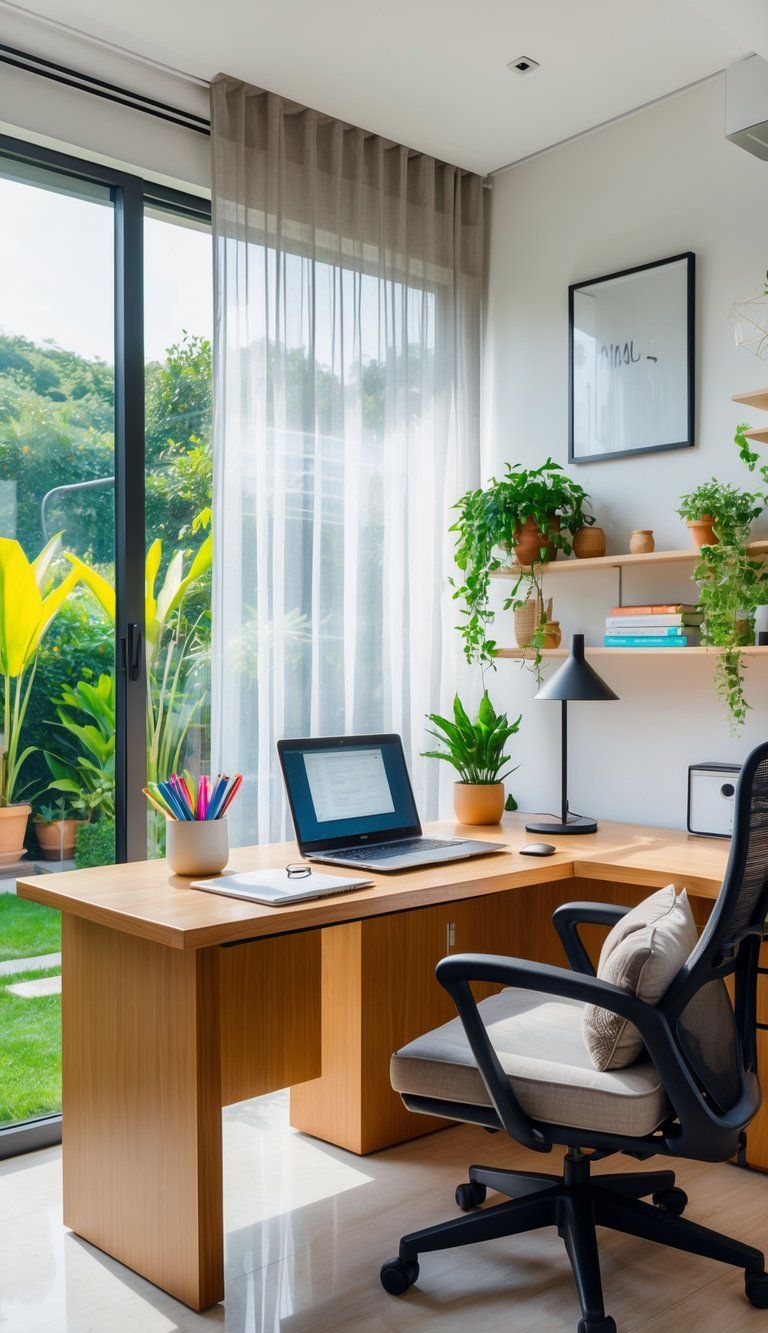
Your workspace shapes how you think and create. With a few tweaks, you can turn your home office into a spot that actually inspires you.
Inspire Creativity Through Layout
How you arrange your space really matters for creative thinking. Place your desk by a window to soak up natural light—it lifts your mood and helps you concentrate. Natural light also cuts down on eye strain and keeps your energy up.
Try an L-shaped or U-shaped desk to make different zones for different tasks. Keep your main area tidy, with just the basics at hand.
Plants are a must. Studies say greenery can boost creativity by up to 15% and lower stress. If you don’t have a green thumb, grab a snake plant or pothos—they’re tough to kill.
Arrange your furniture so you can move around easily. Switching between sitting, standing, and walking helps shake off mental blocks.
Vision Board and Bulletin Boards
A vision board keeps your goals in sight. Hang a cork or magnetic board where you’ll see it every day, and fill it with images, quotes, and reminders that light a fire under you.
Use color-coding to sort projects or work areas on your bulletin board. It makes info easier to spot and remember.
If you’re tight on space, try a digital vision board. Pinterest or even a folder of images on your desktop works just as well.
Switch out items on your board now and then so things stay fresh. Set a reminder to update your vision board with new goals each month.
A whiteboard is great for brainstorming. Being able to erase and redraw quickly helps you get past perfectionism.
Inspirational Quotes and Motivational Decor
Surround yourself with words that actually mean something to you. Pick quotes that hit home, not just generic stuff. Frame them or use wall decals to add them to your space.
Add objects that matter—photos, souvenirs, or awards remind you of good times and wins, which comes in handy on rough days.
Set up a little “inspiration station” with books, art, or items from your field that spark ideas. Change it up when you need new motivation.
Think about color psychology in your decor. Blue calms and helps you focus, yellow fires up creativity, and green keeps things balanced. If painting isn’t an option, use these colors in small decor items.
Don’t overdo it with motivational stuff. A few meaningful pieces are better than a wall of clutter.
Integrating Greenery and Indoor Plants
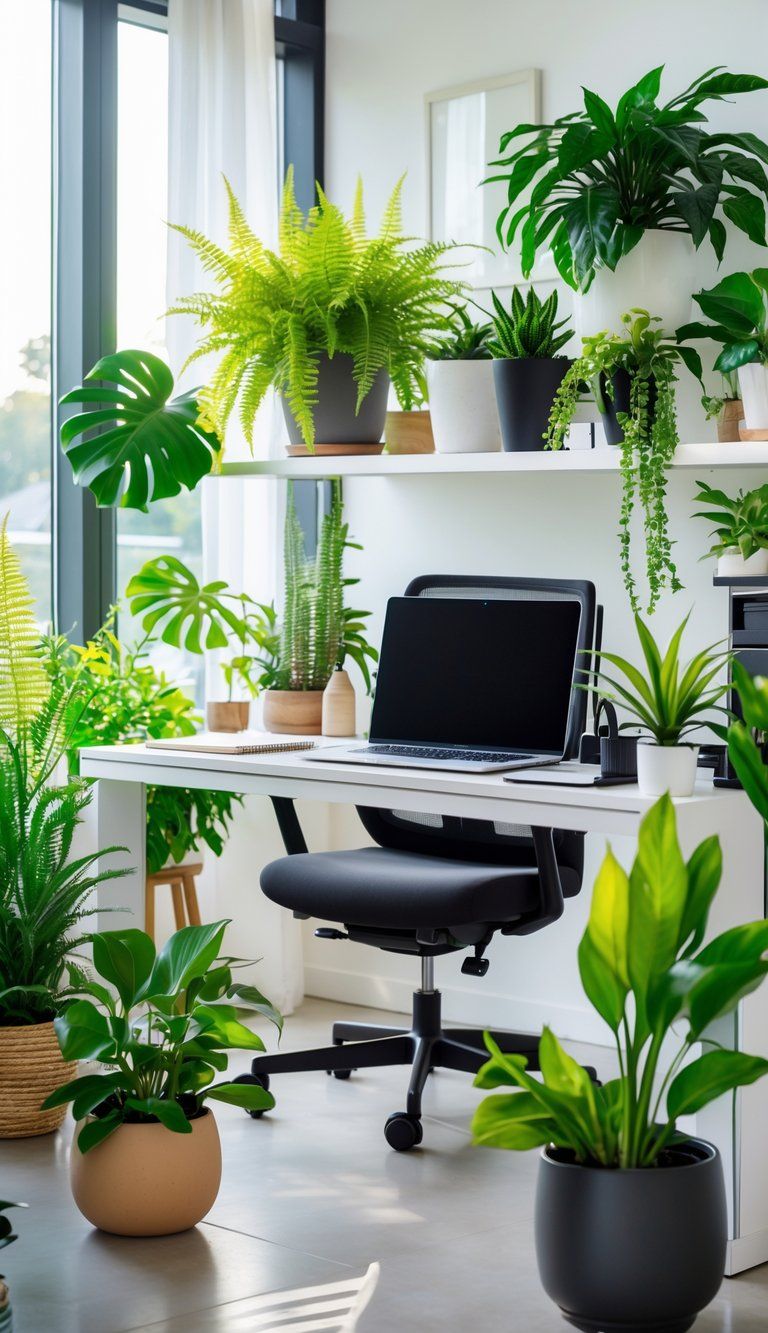
Adding plants instantly makes your home office feel more relaxed and alive. They’re not just for looks—plants actually clean the air and help you stress less during those hectic days.
Benefits of Greenery for Productivity
Plants in your workspace can genuinely boost how you work. Research shows that having greenery nearby can bump up productivity by as much as 15%. Plants filter out toxins and pump out oxygen, so your brain stays sharp.
Being around plants lowers stress, too. Green is naturally calming, and if you’re feeling frazzled, just looking at a leafy plant for a minute can help you reset.
Plants even help with noise. Their leaves absorb sound, so your office feels quieter and more peaceful. That’s a big plus if your space has lots of hard surfaces or is open-plan.
Taking a quick break to water or check on your plants gives your brain a breather from screens. These little pauses help keep burnout at bay during long days.
Choosing the Right Indoor Plants
Not every plant thrives in an office. Choose ones that fit your space and match the level of care you can realistically give.
Low-maintenance options:
- Snake plants
- ZZ plants
- Pothos
- Succulents
These plants need very little water and deal well with a range of light. If you’re busy or travel a lot, they’re honestly a lifesaver.
Check out the light in your office. South-facing windows bring in bright light, which works for plants like fiddle leaf figs.
If your office doesn’t get much sunlight, peace lilies or spider plants are a safer bet.
Think about size, too. Small plants fit nicely on desks without hogging space. Air plants or little succulents do the trick.
For the floor, a monstera or rubber plant can fill out those awkward empty corners.
Don’t crowd your office. Start with just a couple of plants—two or three is plenty at first. You can always add more once you’re used to caring for them.
Too many plants can make a small office feel cramped, and nobody wants that.
Technology and Accessories for Efficiency
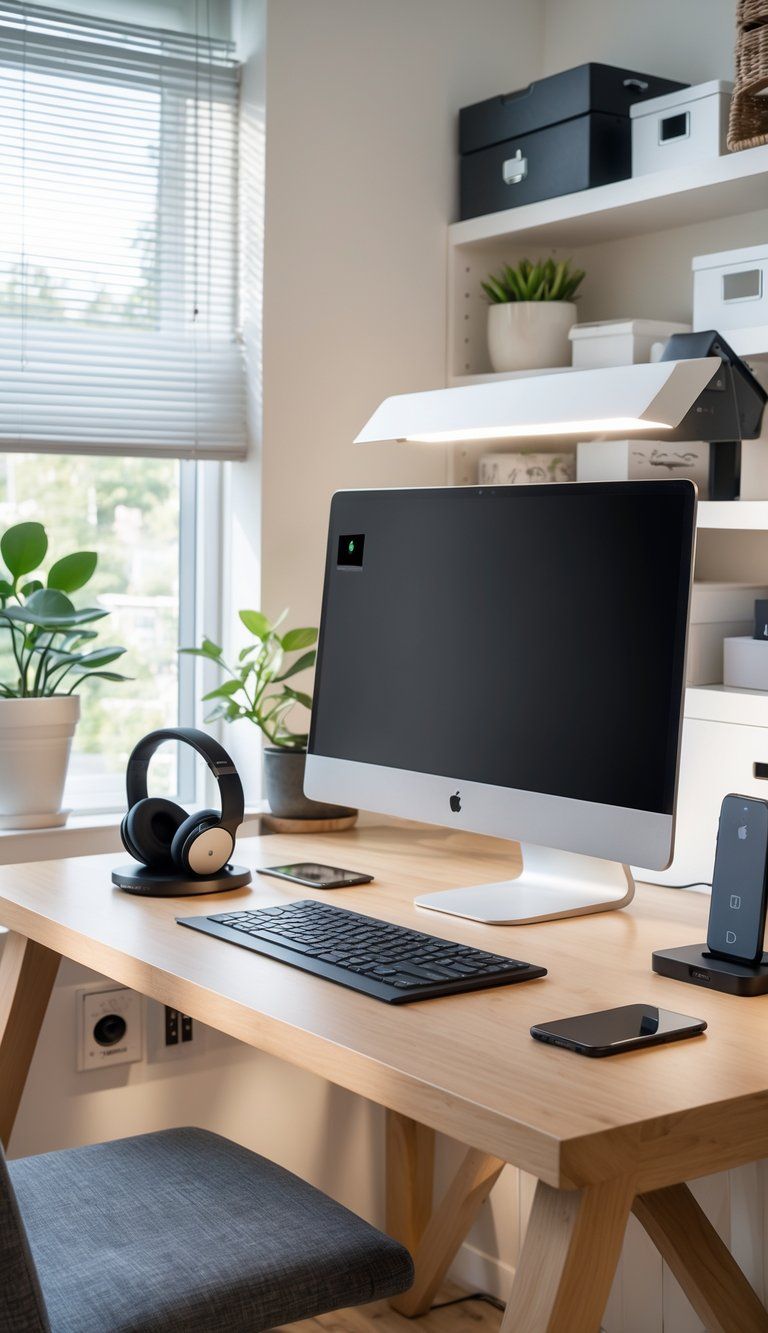
The right tech can turn a plain home office into something much more enjoyable. Good accessories save you time, cut down on stress, and just make the space work better.
Video Call Readiness
Video calls are still a big deal in 2025. You’ll want a quality webcam—aim for at least 1080p resolution so you look sharp.
Set it up at eye level so your calls feel more natural.
Lighting matters, too. A ring light can help you avoid those weird shadows that make you look tired. Stick it right behind your webcam for best results.
Audio is easy to overlook, but it makes a difference. A dedicated microphone will sound way better than your laptop’s mic.
If your house gets noisy, grab some noise-canceling headphones. They’re honestly worth every penny if you need to concentrate.
Pay attention to what’s behind you on camera. A tidy background or even a virtual one helps you look professional and keeps your private life private.
Surge Protectors and Power Solutions
People usually forget about power protection until something goes wrong. A good surge protector keeps your expensive gear safe from power spikes.
Look for these features:
- 2000 joules or more of protection
- LED lights to show it’s actually working
- Enough outlets for everything you use
- USB charging ports (so handy)
Cable management can save you from a tangled mess. Cord clips, sleeves, or cable boxes keep your wires out of the way and make everything look neater.
A portable power station with lots of outlets can be a game changer—just move it wherever you need more plugs.
Smart Devices for the Home Office
Smart tech can make your workday smoother than you’d expect. Voice assistants like Alexa or Google Assistant can set reminders, manage your calendar, or answer quick questions without breaking your focus.
Smart lighting lets you change brightness and color temperature as the day goes on. Bright, cool light helps you wake up and focus in the morning, while softer, warmer tones are easier on your eyes in the afternoon.
A smart thermostat makes sure your office stays comfortable and can even help you save on your energy bill. Some models learn your habits and adjust the temperature for you.
If you print a lot, a wireless printer with smart features lets you send jobs from any device. Some even order ink for you automatically, so you’re never caught off guard.
Embracing Minimalism for Clarity and Focus
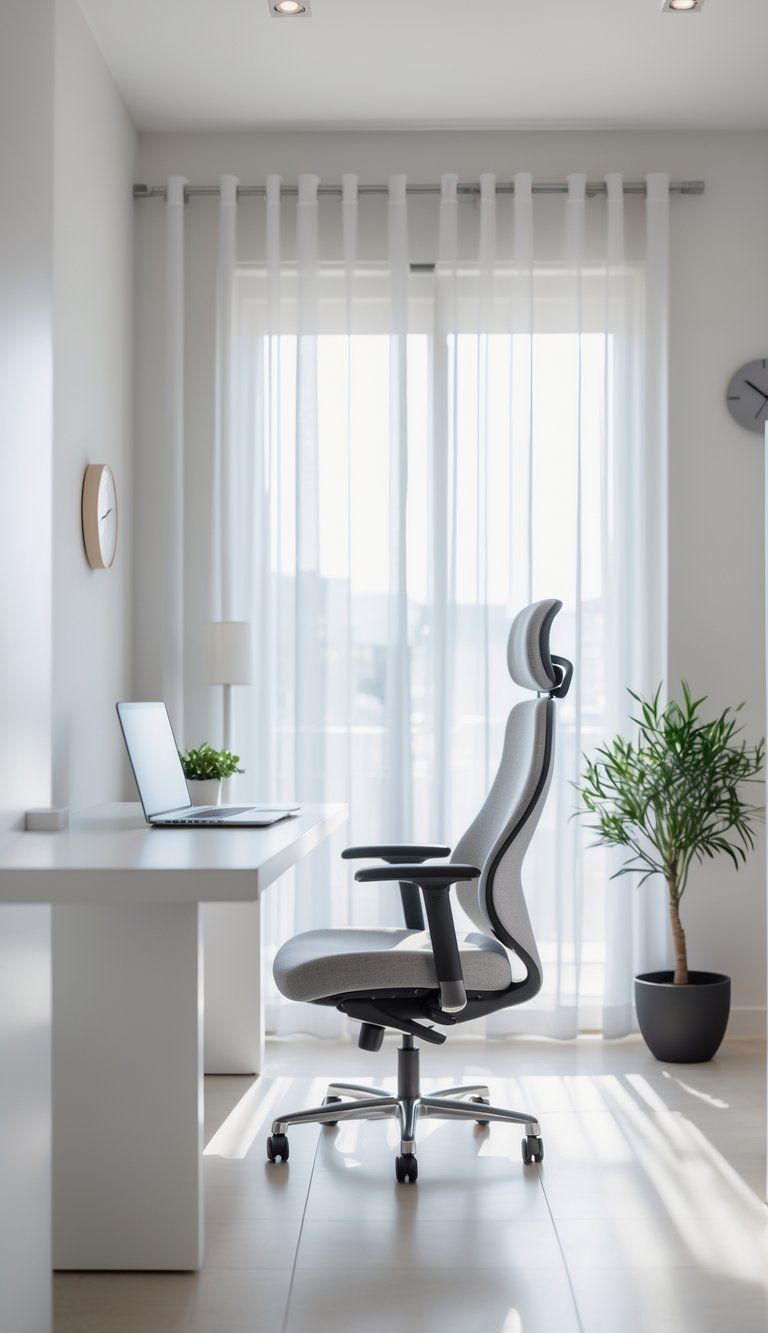
A clutter-free workspace makes it way easier to focus. Minimalism in your home office sets a calm environment where you can actually get things done without distractions everywhere.
Essential Office Supplies Only
Start by figuring out what you really need for your workday. Keep just the essentials—usually a computer, a notebook, and a couple of pens.
Put these basics in spots that make sense for how you work. A simple desk organizer keeps small stuff handy and stops your desk from turning into chaos.
Go digital when you can. Digital notes, documents, and calendars cut down on piles of paper and keep everything easy to find.
Check your supplies every month or so. If you haven’t used something in the last 30 days, it probably doesn’t need to be on your desk. Store seasonal stuff somewhere else or just get rid of it.
Simple Decor Strategies
Pick a neutral color palette and toss in one or two accent colors. That way, you get a calm vibe and nothing feels too busy.
Whites, grays, or natural wood tones work as a solid base. I mean, who doesn’t love a space that feels open and easy on the eyes?
Keep wall decor simple and intentional. Maybe hang one piece of art that inspires you, or just set a small plant on a shelf—enough to give the room some personality, but not enough to make it feel crowded.
Go for furniture with clean lines and some hidden storage. A desk with drawers built in? Total game changer for keeping things tidy without losing that minimalist look.
Let in as much natural light as you can. Try putting your desk close to a window, but don’t forget some basic window treatments so you’re not blinded when the sun’s out in full force.
If you’re adding decorative pieces, think about the rule of three. Just three non-essential items can make the space interesting without turning it into a cluttered mess.

